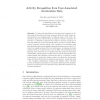Free Online Productivity Tools
i2Speak
i2Symbol
i2OCR
iTex2Img
iWeb2Print
iWeb2Shot
i2Type
iPdf2Split
iPdf2Merge
i2Bopomofo
i2Arabic
i2Style
i2Image
i2PDF
iLatex2Rtf
Sci2ools
PERVASIVE
2004
Springer
2004
Springer
Activity Recognition from User-Annotated Acceleration Data
Abstract. In this work, algorithms are developed and evaluated to detect physical activities from data acquired using five small biaxial accelerometers worn simultaneously on different parts of the body. Acceleration data was collected from 20 subjects without researcher supervision or observation. Subjects were asked to perform a sequence of everyday tasks but not told specifically where or how to do them. Mean, energy, frequency-domain entropy, and correlation of acceleration data was calculated and several classifiers using these features were tested. Decision tree classifiers showed the best performance recognizing everyday activities with an overall accuracy rate of 84%. The results show that although some activities are recognized well with subject-independent training data, others appear to require subject-specific training data. The results suggest that multiple accelerometers aid in recognition because conjunctions in acceleration feature values can effectively discrimi...
Acceleration Data | Applied Computing | Biaxial Accelerometers | PERVASIVE 2004 | Small Biaxial Accelerometers |
| Added | 02 Jul 2010 |
| Updated | 02 Jul 2010 |
| Type | Conference |
| Year | 2004 |
| Where | PERVASIVE |
| Authors | Ling Bao, Stephen S. Intille |
Comments (0)

